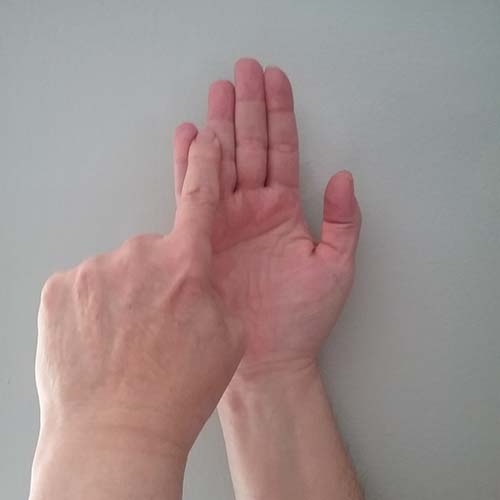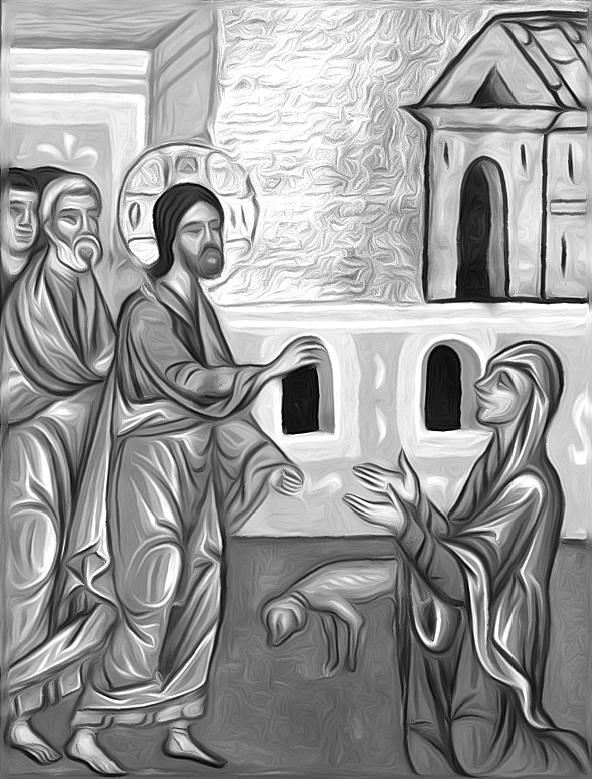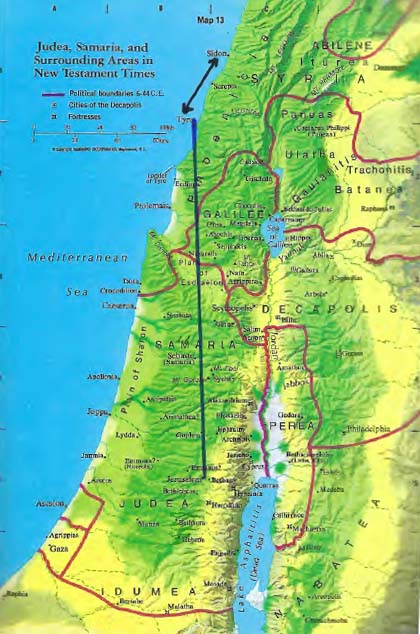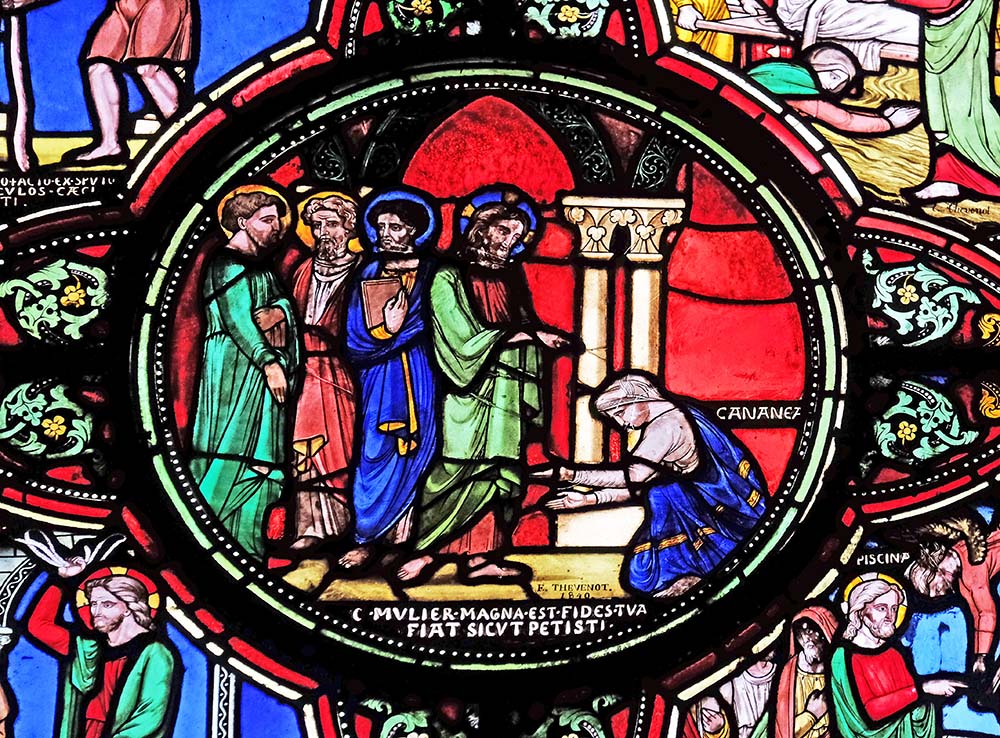“Smitten with the Mitten”
Many of you know that I’m from Michigan. We Michiganders, or Michigooses, in my case, often explain where we live by “pointing to the hand” because it looks like the lower peninsula. We affectionately refer to it as the Mitten. The upper peninsula has a nickname, the Rabbit, because it looks like a rabbit hopping over the Mitten. Especially for those who live in the southern lower peninsula, we have another saying — that “We’re going Up North (to God’s country).” We love it up there.

Any Michigander will know I am pointing to
Traverse City, or possibly the pinky which
is the tiny Leelenau Peninsula.
We take our “Up North” geography very seriously.
Often, we don’t even mention our destination unless someone asks. By saying, “I’m going Up North,” I usually get a response like, “Oh, that’s wonderful! For how long?” Actually, none of us cares where because it’s beautiful everywhere. There is no sign or dividing line to announce that we’re Up North like the Mason-Dixon line between the northern and southern states. But I would say it’s somewhere north of Lansing that we enter Michigan’s magical, mystical state of mind — Up North. I love that there is no line of demarcation. Up North is where our heart takes us.
So, in Michigan-speak, Jesus has “gone Up North;” he has bugged out. Maybe he was on a voluntary silent retreat. The people reject him at the synagogue in Nazareth and nearly throw him off a cliff (“No prophet is honored in his hometown,” Luke 4). Jesus endures constant hassling; Roman and Jewish spies monitor his movements. He needs to get away from it all. And by the way, geographically, he really does go north (see the map below–FYI, it’s not another hand).
Let’s take a look at the text.
21 Jesus left that place and went away to the district of Tyre and Sidon. 22 Just then, a Canaanite woman from that region came out and started shouting, “Have mercy on me, Lord, Son of David; my daughter is tormented by a demon.” 23 But he did not answer her at all. And his disciples came and urged him, saying, “Send her away, for she keeps shouting after us.” 24 He answered, “I was sent only to the lost sheep of the house of Israel.” 25 But she came and knelt before him, saying, “Lord, help me.” 26 He answered, “It is not fair to take the children’s food and throw it to the dogs.” 27 She said, “Yes, Lord, yet even the dogs eat the crumbs that fall from their masters’ table.” 28 Then Jesus answered her, “Woman, great is your faith! Let it be done for you as you wish.” And her daughter was healed instantly. (Matthew 15:21-28, NRSV)

Bazzi Rahib, Ilyas Basim Khuri. The Canaanite Woman Asks for Healing for Her Daughter, from Art in the Christian Tradition, a project of the Vanderbilt Divinity Library, Nashville, TN.
Tyre and Sidon are culturally borderless through diversity
Tyre and Sidon were home to mostly non-Jews. So, from religious and cultural perspectives, Jesus finds himself in a foreign place. In our gospel reading for today, we get a window into Jesus’ mind as he faces what to do about crossing a very taboo border — interacting with a foreign woman. At first, Jesus responds as expected and rejects her. Yet due to the Canaanite woman’s intelligence and eloquence, Jesus genuinely wrestles with what to do — this situation is not as cut and dried as he first thought.

Map of First Century Palestine. The blue line goes from Jerusalem in the south to Tyre, nearly due north from there. The black line shows the distance between Tyre and Sidon.
The confrontation becomes an emotional trial and a legal trial of sorts. Jesus moves to disqualify her testimony, along with all Gentiles. As she represents herself in the impromptu hearing, the Canaanite woman cross-examines Jesus’ reasoning and evidence. He makes a motion to limit his mission to the house of Israel. He insults her by likening her to a dog. Cleverly, she moves to strike his analogy by adopting it. She compares herself and her fellow Canaanites as dogs who eat the scraps under the table. How does one argue with that kind of humility?
A verdict for the Canaanite Woman
Jesus ultimately agrees with her legal analysis and marvels over her great faith. She wins her case, and Jesus grants her requested remedy. He heals the daughter without even going to check out the Canaanite woman’s story. The daughter receives a distance healing–evidence that Jesus recognizes the mother’s great faith.
All is well. This is one of the most extraordinary events in the whole of the Bible. Jesus moves from rejecting this mother to healing her daughter from afar. Because of the Canaanite woman, Jesus now realizes his mission extends much more broadly than he first understood. His mission reaches out to everyone.
How is this story relevant now?
We can draw so much from this passage. We all live on the margins at times, whether spiritually, psychically, physically, morally, or religiously. Sometimes we encounter someone else who struggles. We grapple when we have to decide whether to reject or acknowledge the pain and isolation of others.
Our culture encourages us to stonewall the needs of those who live on the margins compared to us. Typically, our society teaches us that, in some way, the marginalized have to be at fault for their unfortunate circumstances. They didn’t work hard enough or take advantage of opportunities. They are not “like us,” and therefore, we justify separating ourselves from them and creating a superior/inferior relationship with them. We excuse ourselves from responsibility.
Physical and geographical borders are easier to identify
Naturally, geographical borders are usually easy to recognize, and often they are marked by road signs. And, they are almost all made by humans. They separate us by culture, religion, and territory; they are evidence of human governments such as monarchies, democracies, and dictatorships.
So often, geographical borders morph into psychic or emotional limits that we build up in our heads. If enough people buy into the idea, a cultural or cautionary border appears in our minds. These borders almost always come from our fears, inconvenience, or sense of superiority. Borders indicate one thing is about to end, and something else is about to begin.
Negativity about Detroit’s borders
Several years ago, the rap star Eminem made a movie called 8 Mile. It chronicles his life growing up just north of 8 Mile Road, the northern border of Detroit. Crossing that border from the suburbs into Detroit gets interpreted in many ways, mostly negatively. Detroit has had a notorious reputation for crime and poverty for decades — since the 1967 Rebellion. Suburbanites generally stay north of 8 Mile due to fear unless they are going downtown for dining, sports matches, or cultural events. Detroit’s renaissance changes these attitudes, but old habits die hard.
Sometimes we need to embrace conflict
Somewhat surprisingly, Jesus decides to cross into the unknown territory from Palestine because his mission is in crisis. Somewhere along the way, he tries to cross the border into a land of anonymity, but the Canaanite woman knows exactly who he is, Jesus, Son of David. Matthew increases the voltage of this story by cooking up an electrified ethnic stew for us to digest. There should be a sign that reads, “DANGER, HIGH VOLTAGE!” in bright red next to this passage.
Matthew uses loaded terms to convey the power of this story
- Matthew uses the term Canaanite instead of Syrophoenician as in Mark’s Gospel. Note on the map that Tyre and Sidon are in the district of Phoenicia. The word “Canaanite” has a loaded meaning going back to Moses and Joshua. God promised to give Israel the land of the Canaanites when Israel left the desert after 40 years of wandering following their escape from slavery in Egypt. But first, the Israelites had to beat the Canaanites in battle for their land.
- A first-century Palestinian Jew would immediately understand the intended insult in describing someone as Canaanite. Jews considered Canaanites as pagans and, therefore, culturally impure. Political animosity between Canaanites and Israelites was a fact of life. And, calling a Canaanite a dog was a common practice in the time of Joshua.
- A foreign woman would typically not be acknowledged by a Jewish man. The Canaanite woman stands at the intersection of many borders. She’s a Gentile, she’s a woman, she’s unknown to Jesus, and she’s foreign.
- Jesus has been preaching compassion and love for one another, but now he refuses to help. The Canaanite woman is desperate. Her child is sick and maybe dying; she is willing to do anything for her. What might it take for us to experience that kind of desperation?
- Jesus seems to defend the social location of Jewish experience under Roman occupation—they are perpetually hungry and poor, uneducated, driven from their lands to become day laborers, they were in effect, glorified slaves. Jewish people lived a subsistence existence, although the agricultural business boomed in this region.
Jews toiled under a baking sun on land they used to own. However, the grain they teased up from the ground got shipped off to the nearby coast for exportation and substantial profit. They watched as the fruits of their harvest got shipped off to others as they nearly starved.
“Have mercy on me, Lord, Son of David; my daughter is tormented by a demon. Lord, help me.”
The Canaanite woman honors Jesus with proper titles. She utterly debases herself by kneeling before a stranger, a Jewish man, who already views her as culturally impure, and impure as a woman. Jesus is silent. The disciples heckle her, “Send her away.” Send her back to where she came from, into her world, and across the border and away from us. Yet, she is not intimidated and will not give up on him.
The first thing he says is, “I am here only for the lost sheep of the house of Israel. It is not right to take the children’s bread/grain and feed it to the dogs.”
Jesus struggles with this very human impulse to harden his heart, to stonewall her pain and suffering. He uses heavily charged words, like bread and grain, because the people are starving. Jesus has stirred up this encounter with bread, and now Jesus essentially calls her and her people, dogs. Possibly, Jesus refers to a house dog or pet or puppies in the Greek, a less harsh word than a wild, mangy roaming dog, but the implication is irrefutable. Jesus likens a human being to a dog after preaching to care for others. Undeterred, she immediately accepts their different perspectives and uses Jesus’ viewpoint to serve her argument.
“Yes, Lord, but even the dogs eat the crumbs from under the table.”
The Canaanite woman skillfully reminds Jesus of his overarching divine mission. Expertly, she argues that even the least of us, the impure, are happy to receive his ministrations, however nominal. She employs honorific salutations because he is great in her eyes.
This woman’s conduct is culturally shameful, yet she has no shame in her desperation—Jesus alone is her only hope. She has dismissed the vast cultural divide between her and Jesus. She demonstrates how she will grovel for the crumbs under the table. Certainly, her audacity in kneeling before a strange man shocks the audience because such action is so radical. Her reputation and livelihood are on the line, and she doesn’t care. She has emptied herself spiritually before Jesus by resisting at all cost.
What might it take for us to be in her shoes?
She is lightning fast, wise, and unrelenting. They are in a verbal fencing match, thrust and parry until finally, she pierces his heart with her wisdom. She foils his resistance. She has reframed his mission to be open to the gentiles by her courageous words and deeds.
The Canaanite woman pulls Jesus across that hidden border of his humanity and draws him back across into his divinity. Her words empower and invoke the Gentile ministry of the Word, Jesus. Her words have informed the Logos, who is Jesus-the-Word. Astonishingly, she has stopped him in his tracks, interrupted him, and offered him grace within which to change his mind and to err on the side of compassion rather than caution. And finally, to remember himself as the Holy Redeemer.
What borders do we wrestle with as Americans?
In truth, as the COVID-19 pandemic devastates our national economy, it also exposes how people of color suffer. We live in a racist society—one that exploits people of color automatically, and many of us are blind to its existence and to the effect it has on all of us.
Sexism is alive and well. The #MeToo Movement has revealed the ugliness of predatory quid pro quo entrenched in our daily life. “Have sex with me or else . . . you lose your job, or a coveted movie role, or your life in countless domestic murders. Latin Americans stagnate in our horrible “detention” camps, or rather concentration camps, amidst squalor and humiliation because they dare to cross into the so-called “land of opportunity.”
Our democracy stands on an invisible border at present. The American society rests in a precarious transitory place between freedom and fascism. Many, many borders challenge our sense of decency and compassion. We must decide whether protecting freedom is worth the sacrifice it will take to return to democracy.
The Reign of God has no borders
And yet, as Christians, we are called to help others. We look at photos of so many little children at the southwest American border. Desperate parents risk it all, even the lives of children, to improve their situation. Often we find ourselves in the same predicament as Jesus was. He was trying to get out of the situation. He had his own issues. However, the Canaanite woman redirects his mission! Everything changes from that point. It is a transformational moment. Remember Isaiah! “My house shall be a house of prayer for all peoples!”
What does Jesus say as he ascends into heaven and the end of Matthew? “Go therefore, and make disciples of ALL nations. Remember, I am with you to the end of the age.”
How do we wrestle with conquering the internal borders that wall us away from others in need?
Ultimately, we must continue to allow ourselves to be stopped in our tracks by the marginalized. Let us pray that we open ourselves to that Voice, to follow Jesus’ mission-altering decision. When hearts open, we will hear God calling us to encourage and to help those on the margins wherever and whenever we can and not be satisfied that we have finally done enough. The Reign of God has no borders. As earthly citizens of that heavenly country, we must eradicate borders and destroy the barriers that separate us from being the compassionate disciples of Jesus. We must remember ourselves.






1 thought on “The Canaanite Woman Changes Jesus’ Mind about His Entire Ministry to All”
This is a well-delineated discussion of the cultural conflicts that arise in this portion of Matthew’s Gospel. Courage and faith on the part of the Gentile woman have an astounding impact on Jesus’s ministry. Rev. Dr. Marcia does masterful work pointing to where we, as followers of Jesus, need to work with the same courage and faith in righting the deadening sin of racism and cultural hegemony, among other ills of humanity. I knew, when I read the description of this gospel story as “an electrified ethnic stew for us to digest”, that I was in for a meaty discourse!
Comments are closed.